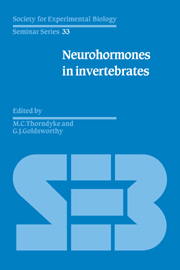Book contents
- Frontmatter
- Contents
- List of contributors
- Preface
- What is special about peptides as neuronal messengers?
- Part I Immunocytochemistry and Ultrastructure
- Part II Arthropod Neurohormones
- Part III Neurohormones in Coelenterates, Annelids and Protochordates
- Structure, location and possible actions of Arg–Phe–amide peptides in coelenterates
- Neuropeptides and monoamines in annelids
- Functional aspects of peptide neurohormones in protochordates
- Part IV Neurohormones in Molluscs
- Index
Structure, location and possible actions of Arg–Phe–amide peptides in coelenterates
Published online by Cambridge University Press: 04 August 2010
- Frontmatter
- Contents
- List of contributors
- Preface
- What is special about peptides as neuronal messengers?
- Part I Immunocytochemistry and Ultrastructure
- Part II Arthropod Neurohormones
- Part III Neurohormones in Coelenterates, Annelids and Protochordates
- Structure, location and possible actions of Arg–Phe–amide peptides in coelenterates
- Neuropeptides and monoamines in annelids
- Functional aspects of peptide neurohormones in protochordates
- Part IV Neurohormones in Molluscs
- Index
Summary
Introduction
Coelenterates have the simplest nervous system in the animal kingdom, and it was probably within this group of animals that nervous systems first evolved. Extant coelenterates are diverse and comprise two phyla. The classes Hydrozoa (for example hydroids and their medusae), Cubozoa (box jellyfishes), Scyphozoa (true jellyfishes), and Anthozoa (for example sea anemones and corals) constitute the phylum Cnidaria. A companion phylum is that of the Ctenophora (comb jellies), or Acnidaria. The general plan of the coelenterate nervous system has often been described as a nerve net. This is an oversimplification because many species show condensation of neurones to form linear or circular tracts. Linear tracts occur in the stem and tentacles of physonectid siphonophores (Mackie 1973; Grimmelikhuijzen et al. 1986), between the ocelli and marginal nerve rings of anthomedusae (Singla & Weber 1982; Grimmelikhuijzen & Spencer 1984), and at the bases of mesenteries in sea anemonies (Batham et al. 1960). Circular tracts, or nerve rings, have been found in the bell margin of hydrozoan medusae (Hertwig & Hertwig 1878; Jha & Mackie 1967; Spencer 1979; Grimmelikhuijzen et al. 1986) and at the base of the hypostome in some hydrozoan and cubozoan polyps (Werner et al. 1976; Grimmelikhuijzen 1985). Presumably, these tracts have evolved to form pathways for rapid conduction of information. The marginal nerve rings of hydromedusae, in addition, form a circular CNS, which is capable of both integrating a variety of sensory inputs, and of transmitting the input rapidly throughout the margin (Spencer & Arkett 1984).
- Type
- Chapter
- Information
- Neurohormones in Invertebrates , pp. 199 - 218Publisher: Cambridge University PressPrint publication year: 1988
- 19
- Cited by



